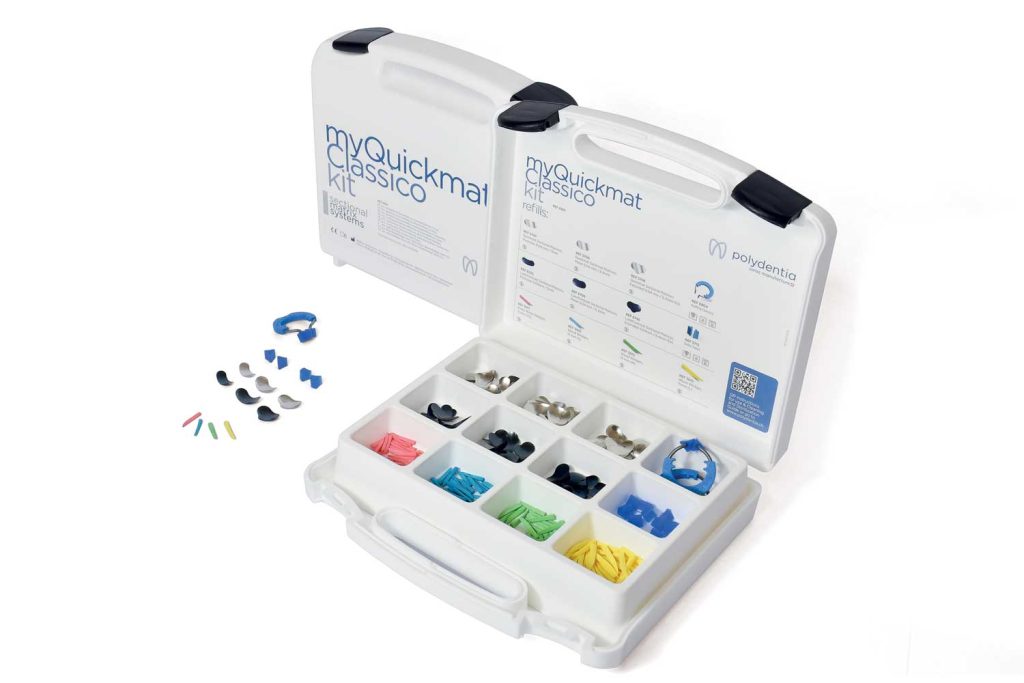Restore like a pro
Featured Products Promotional FeaturesPosted by: Dental Design 22nd May 2022

Most clinicians will encounter Class II cavities regularly in their day-to-day practice. Despite their prevalence, Class II cavities are still a challenge to treat; there are various possible complications that can arise that will compromise the success of the restoration.
Minimising these complications is vital to ensure that the patient receives functional and aesthetic restorations. By gaining the skills and knowledge to combat these issues, clinicians can perform Class II restorations with ease and confidence.
Post-operative sensitivity
When using composite materials for a restoration, there is the potential for polymerisation shrinkage, placing stress between the tooth and restoration, triggering complications such as microgaps.[i] This can manifest clinically as post-operative sensitivity (POS),[ii] amongst various other issues. Not only does this cause discomfort for the patient, but it also reduces the stability of the restoration.
There is much literature on the topic of overcoming these challenges; bulk-fill composites were suggested as an alternative to conventional composites.[iii] They demonstrated lower cusp strain, reduced shrinkage stress and higher fracture resistance.iii Bulk-fill composites are also generally considered to be easier-to-use and more clinically reliable, maximising valuable chair-time.[iv]
Due to the various causes of POS, there are many deliberations that clinicians must make. Among these, the type of material they employ can determine the outcome of the procedure.
Secondary caries
Secondary caries, or recurrent caries, is considered one of the leading causes of dental restoration failure.[v] This multifactorial process has been associated with defective restorations, via gaps between the tooth and restoration[vi] that allow acidic by-products or dysbiotic biofilm to enter.[vii] Another cause has been associated with intact restorations – this may be caused by the restoration’s low buffering capacity, [viii] which has been linked to caries development and reduced re-mineralisation. Primary caries adjacent to existing restorations may also trigger secondary caries. The patient’s own susceptibility to caries is another risk factor.iii
To ensure the good health of the patient, and the success of the restoration, how can clinicians lessen the occurrence of secondary caries? The possible impact of restorative material on its development has been noted,[ix] however, researchers have suggested that this risk is limited.ii Fluoride-releasing glass ionomer cements were shown to exhibit an inhibiting effect, in vitro, on secondary caries in comparison to resin composites.[x] Composites are popular, due to their aesthetics and mechanical and physical properties – however, not only are they susceptible to secondary caries, but they are also at risk of excessive wear and restoration fracture.[xi] Progressions in the advancements of this material are helping clinicians lower these risks and improve how they deliver care.
Contact point design
 Restoring proximal contact points is another factor in a restoration’s long-term success.[xii] In Class II restorations, ensuring that there are no open contact points can be challenging for many clinicians, but it is a vital step to prevent food impaction and damage to the interproximal tissues.[xiii]
Restoring proximal contact points is another factor in a restoration’s long-term success.[xii] In Class II restorations, ensuring that there are no open contact points can be challenging for many clinicians, but it is a vital step to prevent food impaction and damage to the interproximal tissues.[xiii]
The matrix system selected by the clinician can impact the final contact points between the site being restored and its adjacent tooth. It is crucial that the matrix system used facilitates successful restoration of the proper morphology of the interproximal contact points. One study[xiv] argued that using a sectional matrix achieved a strong contact point in Class II restorations, with further research[xv] stating that a combination of sectional matrices and separation rings provided a stronger proximal contact when compared with circumferential matrix systems.
With the wealth of restorative solutions available today, clinicians can carefully assess which high-quality products will maximise the outcomes of their treatment.
Invest wisely, restore confidently
To maximise restoration outcomes, investing in high-grade, reliable solutions will help clinicians treat their patients confidently and efficiently. J&S Davis delivers the most cutting-edge solutions and systems available throughout the UK, such as the restorative product portfolio from Swiss manufacturer Polydentia.
This innovative range of solutions covers a broad spectrum of clinical indications. For Class II restorations, the myClip 2.0, my Quickmat Forte and myQuickmat Classico are ideal for providing ideal separation forces for optimal contact points. The Polydentia portfolio also provides solutions for Class III, IV and V restorations, such as the Unica anterior matrix solution.
Class II restorations may be a common sight in the dental practice, but their treatment still remains potentially challenging. When clinicians ensure that the tools and materials they use are high-quality and durable, they can make tricky Class II restorations a thing of the past.

For more information on the industry-leading products available from J&S Davis, visit www.js-davis.co.uk, call 01438 747 344 or email jsdsales@js-davis.co.uk
[i] Vasconcelos-Monteiro, R., Cavalcanti-Taguchi, C.-M., Gondo-Machado, R., Batalha-Silva, S., Karina-Bernardon, J., Monteiro-Junior, S., Vasconcelos-Monteiro, R., Cavalcanti-Taguchi, C.-M., Gondo-Machado, R., Batalha-Silva, S., Karina-Bernardon, J. and Monteiro-Junior, S. (2019). Bulk-Fill Composite Restorations Step-by-Step Description of Clinical Restorative Techniques Case Reports. Odovtos International Journal of Dental Sciences, [online] Available at: https://www.scielo.sa.cr/scielo.php?script=sci_arttext&pid=S2215-34112019000200023 [Accessed 23 Feb. 2022].
[ii] biocoreopen.org. (n.d.). Immediate Post-operative Sensitivity after Composite Resin Restoration – A Review of Treatment Protocol. [online] Available at: https://biocoreopen.org/ijdoh/Immediate-Post-operative-Sensitivity-after-Composite-Resin-Restoration-A-Review-of-Treatment-Protocol.php#:~:text=Post%2Doperative%20sensitivity%20in%20teeth [Accessed 23 Feb. 2022].
[iii] Rosatto, C.M.P., Bicalho, A.A., Veríssimo, C., Bragança, G.F., Rodrigues, M.P., Tantbirojn, D., Versluis, A. and Soares, C.J. (2015). Mechanical properties, shrinkage stress, cuspal strain and fracture resistance of molars restored with bulk-fill composites and incremental filling technique. Journal of Dentistry, [online] Available at: https://www.sciencedirect.com/science/article/abs/pii/S0300571215300476 [Accessed 23 Feb. 2022].
[iv] Arbildo-Vega, H.I., Lapinska, B., Panda, S., Lamas-Lara, C., Khan, A.S. and Lukomska-Szymanska, M. (2020). Clinical Effectiveness of Bulk-Fill and Conventional Resin Composite Restorations: Systematic Review and Meta-Analysis. Polymers, [online]. Available at: https://www.ncbi.nlm.nih.gov/pmc/articles/PMC7464794/#:~:text=Currently%2C%20bulk%2Dfill%20resin%20composites,cure%20%5B8%2C9%5D. [Accessed 23 Feb. 2022].
[v] Nedeljkovic, I., De Munck, J., Vanloy, A., Declerck, D., Lambrechts, P., Peumans, M., Teughels, W., Van Meerbeek, B. and Van Landuyt, K.L. (2019). Secondary caries: prevalence, characteristics, and approach. Clinical Oral Investigations, [online] Available at: https://link.springer.com/article/10.1007/s00784-019-02894-0 [Accessed 22 Feb. 2022].
[vi] Askar, H., Krois, J., Göstemeyer, G., Bottenberg, P., Zero, D., Banerjee, A. and Schwendicke, F. (2020). Secondary caries: what is it, and how it can be controlled, detected, and managed? Clinical Oral Investigations, [online] Available at: https://link.springer.com/article/10.1007/s00784-020-03268-7#Sec4 [Accessed 22 Feb. 2022].
[vii] Schwendicke, F., Splieth, C.H., Bottenberg, P., Breschi, L., Campus, G., Doméjean, S., Ekstrand, K., Giacaman, R.A., Haak, R., Hannig, M., Hickel, R., Juric, H., Lussi, A., Machiulskiene, V., Manton, D., Jablonski-Momeni, A., Opdam, N., Paris, S., Santamaria, R. and Tassery, H. (2020). How to intervene in the caries process in adults: proximal and secondary caries? An EFCD-ORCA-DGZ expert Delphi consensus statement. Clinical Oral Investigations, [online] Available at: https://link.springer.com/article/10.1007%2Fs00784-020-03431-0 [Accessed 22 Feb. 2022].
[viii] Chifor, I. (2014). SALIVA CHARACTERISTICS, DIET AND CARIORECEPTIVITY IN DENTAL STUDENTS. Clujul Medical, [online] Available at: https://www.ncbi.nlm.nih.gov/pmc/articles/PMC4462414/#b5-cm-87-34 [Accessed 22 Feb. 2022].
[ix] van de Sande, F.H., Opdam, N.J.M., Truin, G.J., Bronkhorst, E.M., de Soet, J.J., Cenci, M.S. and Huysmans, M.-C. (2014). The Influence of Different Restorative Materials on Secondary Caries Development in situ. Journal of dentistry, [online] Available at: https://www.ncbi.nlm.nih.gov/pmc/articles/PMC4134988/#:~:text=Secondary%20or%20recurrent%20caries%20is [Accessed 22 Feb. 2022].
[x] Krämer, N., Schmidt, M., Lücker, S., Domann, E. and Frankenberger, R. (2017). Glass ionomer cement inhibits secondary caries in an in vitro biofilm model. Clinical Oral Investigations, [online] Available at: https://link.springer.com/article/10.1007/s00784-017-2184-1 [Accessed 22 Feb. 2022].
[xi] Zhou, X., Huang, X., Li, M., Peng, X., Wang, S., Zhou, X. and Cheng, L. (2019). Development and status of resin composite as dental restorative materials. Journal of Applied Polymer Science, [online] Available at: https://onlinelibrary.wiley.com/doi/full/10.1002/app.48180 [Accessed 23 Feb. 2022].
[xii] Manicone, P.F., De Angelis, P., Papetti, L., Rella, E., De Angelis, S. and D’Addona, A. (2022). Analysis of Proximal Contact Loss Between Implant Restorations and Adjacent Teeth: A 10-Year Retrospective Study. The International Journal of Periodontics & Restorative Dentistry, [online] Available at: https://pubmed.ncbi.nlm.nih.gov/34851328/ [Accessed 22 Feb. 2022].
[xiii] Manicone, P.F., De Angelis, P., Rella, E., Papetti, L. and D’Addona, A. (2021). Proximal Contact Loss in Implant‐Supported Restorations: A Systematic Review and Meta‐Analysis of Prevalence. Journal of Prosthodontics. [online] Available at: https://onlinelibrary.wiley.com/doi/abs/10.1111/jopr.13407 [Accessed 23 Feb. 2022].
[xiv] de la Peña, V.A., García, R.P. and García, R.P. (2016). Sectional matrix: Step-by-step directions for their clinical use. British Dental Journal, [online] Available at: https://www.nature.com/articles/sj.bdj.2016.18 [Accessed 23 Feb. 2022].
[xv] Loomans, B.A.C., Opdam, N.J.M., Roeters, F.J.M., Bronkhorst, E.M., Burgersdijk, R.C.W. and Dörfer, C.E. (2006). A randomized clinical trial on proximal contacts of posterior composites. Journal of Dentistry, [online] Available at: https://www.sciencedirect.com/science/article/abs/pii/S0300571205001478 [Accessed 23 Feb. 2022].
No Comments
No comments yet.
Sorry, the comment form is closed at this time.



